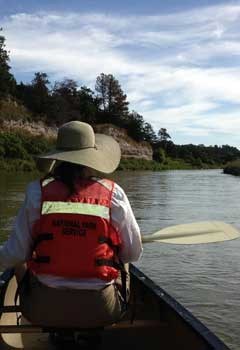
NPS Photo/Ed Harvey
Background
The National Park Service (NPS) seeks to protect and conserve surface waters and groundwaters in park units as integral components of water and land ecosystems. The Water Rights Program and Branch (WRB) in the Water Resources Division was established in 1985 and provides staff expertise and resources to effectively address water-quantity and water-right issues for NPS units throughout the United States. The program secures and protects water rights, flows, and lake and groundwater levels for the preservation and management of the national park system through all available local, state, and federal authorities.
What We Do
WRB performs five basic functions:
-
Develops and applies legal and technical strategies to secure and protect water quantity and water rights
-
Provides legal and technical expertise to park, region, and Washington staff regarding potential threats to water quantity and water rights at national park units
-
Collects and maintains NPS water-quantity and water-right records
-
Collects and analyzes ground and surfacewater data
-
Educates NPS staff and stakeholders about protecting NPS water rights and water-related resources
WRB also co-leads the NPS national Wild and Scenic Rivers (WSR) program and works closely with the WSR Steering Committee to consistently implement protection and enhancement measures for riverine resources. WRB works closely with parks, regions, other federal agencies and partners to assure that proposed water projects do not injure the free-flowing condition, water quality, and outstandingly remarkable values for each designated stream segment.
Highlights and Accomplishments
-
WRB has secured water rights through adjudications, settlements, court decrees, and other procedures for many parks in the western United States, including nine parks in Arizona, two in California, six in Colorado, five in Idaho, six in Montana, three in Nevada, and seven in Utah.
-
WRB reviews water right applications and development proposals to protect existing water rights or secure instream flows, spring flows, lake levels, and groundwater levels at park units. In addition, WRB develops scientific products that are used by courts and hearing officers to make water allocation decisions.
Other examples include:
-
WRB filed protests with the Nevada State Engineer for groundwater applications up- gradient of Death Valley National Park, Lake Mead National Recreation Area, and Great Basin National Park that would likely injure water-related resources (e.g., stream flow, springs, desert pupfish). WRB has resolved protests through settlements that commit parties to collect scientific data to improve decision-making processes. These data have been used by the State Engineer to implement staged water development, enhancing protection of NPS resources.
-
WRB filed protests with the Oklahoma Water Control Board regarding proposed groundwater use for aggregate mining in the Arbuckle-Simpson aquifer in southern Oklahoma near Chickasaw National Recreation Area. The park was established to protect springs and associated streams, and the State and WRB are using a recently completed groundwater model to assess impacts of water development and mining on NPS resources.
-
WRB is concerned that proposed water development near Kaloko-Honokohau National Historic Park will injure cultural and natural resources that rely on the continued flow of fresh groundwater from upland areas. WRB is collecting and analyzing data, funding new science, and working with the State of Hawaii and partners to consider implementation of a water protection area.
Status
The NPS must participate in water right adjudications and State administrative proceedings or risk losing or injuring water rights and water-dependent resources. WRB is currently involved in adjudications and administrative procedures in eleven western states: Arizona, Colorado, Idaho, Montana, Nebraska, Nevada, New Mexico, North Dakota, Oregon, South Dakota, and Wyoming.
In addition, WRB works with parks in the eastern United States to secure water rights and/or develop water quantity protection strategies through administrative processes such as environmental assessments, U.S. Army Corps of Engineers 404 permitting processes, Rural Utility Service loan approvals, Federal Highway Transportation project reviews, and Endangered Species processes.
Streams, springs, lake levels, and groundwater play a critical role in protecting water-dependent plants and animals, recreational activities, and scenery in our national parks. WRB will continue to collect data, implement sound science, and participate in all available forums to protect these important resources.
Contact the Water Rights staff.
Last updated: January 25, 2018
